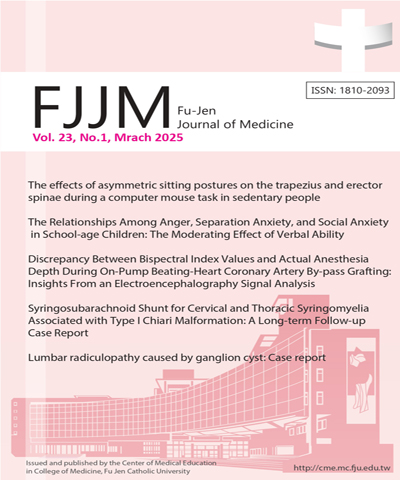
輔仁醫學期刊/Fu-Jen Journal of Medicine
輔仁大學醫學院,正常發行
選擇卷期
- 期刊
Objective: Epidural low concentration local anesthetics combined with opioids are widely used in labor analgesia. However, whether epidural low concentration local anesthetics decrease the degree of sympathetic block is not clear. Methods: Forty nulliparous parturients admitted for spontaneous vaginal delivery were enrolled and randomly assigned into group A and B. Epidural labor analgesia was initiated with 15 ml 0.07 % ropivacaine with 50 μg fentanyl for group A parturients and 15 ml of 0.25 % ropivacaine for group B parturients followed by a 12 ml/hr infusion of 0.07% ropivacaine plus 2 μg/ml fentanyl. Skin temperature and skin blood flow of the hand and foot were measured before and 30 minutes after the beginning of epidural analgesia by the temperature probe and laser-Doppler flowmetry. Results: Skin temperature of the foot increased more in group B parturients 30 min after epidural analgesia than group A parturients (Group A: +0.5 ± 1.3 °C; Group B: +3.5 2.4 °C; p < 0.001). Skin blood flow of the foot also significantly increased in group B parturients (Group A: +9 ± 62%; Group B: +195 ± 318%; p = 0.01). On the contrary, skin temperature and blood flow of the hand slightly decreased in group B parturients but slightly increased in group A parturients (p = 0.01 and 0.09, respectively). Conclusions: Epidural 15 ml 0.07% ropivacaine plus 50μg fentanyl for labor analgesia produced less sympathetic block and also provided good quality of analgesia at the beginning of labor.
- 期刊
Evidence Based Medicine (EBM) has become one of the most popular and effective research methods to investigate on medical-related science fields. It integrates previous researches, aiming to inspect and accomplish a deeper understanding in the already existing opinions and results. This article aims to make an approximation on understanding how to conduct EBM using meta-analysis and systematic review for academic evidences. Consequently, throughout the present article, network meta-analysis are also introduced. EBM has proofed to efficiently promote a more effective research method when obtaining scientific evidence, simultaneously improving expectations to be more practical on clinical application. Additionally -and in order to maintain the article's liability- it was considered necessary to specify and tackle the most relevant pros and cons.
- 期刊
A 65-year-old woman with a previous history of acute angle-closure glaucoma received femtosecond laser-assisted cataract surgery (FLACS) at our hospital. The patient's pupil diameter was about 4mm and could not be dilated preceding the operation. We performed corneal microincision following pupil dilation with OVDs (Viscoat, Alcon Laboratories, Inc.). Lens fragmentation and capsulotomy were not able to be performed by FEMTO LDV Z8. We replaced the dispersive OVD--Viscoat, with an alternative cohesive OVD--Protectalon. After replacement, lens fragmentation and capsulotomy were performed smoothly under the same femtosecond laser settings. We propose the componential difference of the two OVDs, as well as lower laser pulse energy of FEMTO LDV Z8, might contribute to our reported complication. Our hypotheses require further studies with better study designs to validate. We hope this experience might reveal effects of different OVDs on FLACS and also help solve possible difficulties during FLACS on a very smaller pupil and shallow ACD cataract.
- 期刊
Optic neuritis (ON) in a patient of systemic lupus erythematosus (SLE) overlapping with neuromyelitis optica spectrum disorder (MNOSD) was a rare occasion. We presented a 24-year-old female with the complaint of progressive visual loss associated with eye pain in the right eye for 5 days. She had past history of SLE with well control. Her vision decreased to hand motion. Right optic neuritis was impressed after ocular examination. Pulse steroid for 3 days was given and followed by slow tapering oral steroid. Further evaluation revealed positivity of AQP4-IgG and immunosuppressive therapy was augmented. Her vision improved to 20/25 after treatment. The presence of ON in a patient of SLE should warrant the testing for AQP4-IgG. Although there are no specific recommendations for the treatment of SLE/ MNOSD overlapping cases, early pulse steroid was necessary. Long term immunosuppression should be considered as an effective way to attack prevention.
- 期刊
In this article, we report the case of a 75-year-old female who was admitted to our hospital due to a painful mass over her right flank region. Twenty months prior to the admission, the patient had undergone laparoscopic cholecystectomy (LC). The computed tomography images revealed hyperdense lesions located at the common bile duct that had migrated to the abdominal wall. A surgical removal of two stones and pus content was performed. Based on the stone analysis and the surgical history, the patient was diagnosed with gallstone granuloma. After a short period of hospitalization, the patient was discharged with no complications. We believe that our report makes a significant contribution to the literature because reports of infectious complications due to unretrieved stones after LC are rare.

